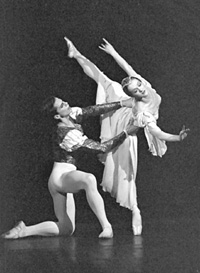<I>Romeo and Juliet</I> — New Interpretation of Eternal Subject

The IV International Serge Lifar de la Dance Ballet Festival, which presented the choreography lovers with two wonderful evenings of the feast of the dance, is over now.
The gaudy ornamentation associated with official ceremonies — the arrival of Lifar’s widow Ms. Lillan Ahlefeldt, visits to museums and attendance of concerts by our high officials as a part of the event, is also over, and to recall the continuity of generations, the National Opera of Ukraine will have in its repertoire Tchaikovsky’s ballet Romeo and Juliet in the original production by Serhiy Mykhailovych Lifar, which has become the first sign of the return of his choreography to his native country.
Serge Lifar achieved international fame as a dancer and choreographer. For over thirty years he led the Grand Opera Ballet troupe. He did not accept the French citizenship offered to him by President Charles de Gaulle, saying proudly in reply, “I am Ukrainian,” and until his death in 1986 remained stateless. According to his wife Lillan, he missed Kyiv all his life. He left great creative heritage behind: over 200 ballets. Now we also have a chance to see his productions. Countess Ahlefeldt, touched by the warm welcome accorded her and genuine interest in the works of her late husband, promised at the meeting with President Kuchma before returning home to Lausanne (Switzerland) that she will hand over all Serge Lifar’s belongings to his homeland, Kyiv.
In an ordinary spectator, Romeo and Juliet provokes ambivalence. From today’s standpoint, the choreography looks somewhat archaic. It seems that our fellow countryman was a pioneer in the creation of private theatrical enterprises. Shakespeare’s hymn to lovers, set to Tchaikovsky’s music, has a solution in a reading-book context. The main events of the plot — they meet, declare their love, the duel is fought, and they die — are pressed into twenty minutes. Minimalism dominates: two performers, Romeo (Yevhen Kolesnyk and, on the second day, Serhiy Yehorov), and Juliet (Natalia Kalynychenko and Nadiya Honchar as the second cast), with the black backdrop of the stage used as the setting. For a few instances, the side scenes open, showing a balcony, then a part of the crypt and the coffin. The solution for the duel is unusual as well: instead of the bully Tibalt Romeo fights his own shadow, and in the finale the blackness is exchanged by blue skies. There comes a drum roll, suddenly followed by a deafening silence. Seconds seem eternity. And the lovers begin to resurrect. They grope their way like they are blind. Serge Lifar changes Shakespeare’s ending, For never was a story of more woe Than this of Juliet and her Romeo. Sorrow is supplanted by hope. For true love is eternal!
Having attended the premier of Romeo and Juliet, Ms. Ahlefeldt on the whole rated the performance highly, encouraging the first cast of Natalia Kalynychenko and Yevhen Kolesnyk, but she also noted that the light, sound, that is the technical provision of the ballet does not conform to modern standards and these issues should be solved as soon as possible. She wants to popularize the works of her husband through our ballet. His famous play Icare will be their next to be staged. This will enable our National Opera to hold Lifar choreography soirees.






